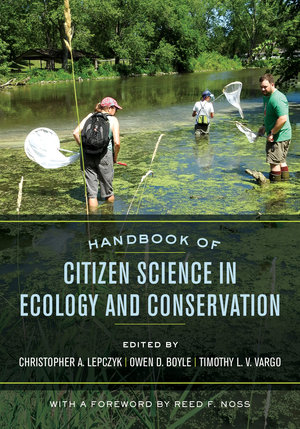As part of our #ESA2021 virtual conference series, we reached out to co-editors Christopher Lepczyk, Owen Boyle, and Timothy Vargo to discuss their new book, Handbook of Citizen Science in Ecoloy and Conservation. The book is the first practical and comprehensive manual for creating, implementing, or improving natural science research and monitoring projects that involve collaboration between scientists and the general public. Citizen science practitioners from around the world and with decades of experience provide step-by-step instructions, insights, and advice, and they explore real-world applications through case studies from a variety of citizen science projects.
Christopher A. Lepczyk is Professor in the School of Forestry and Wildlife Sciences at Auburn University.
Owen D. Boyle is Chief of Species Management for the Wisconsin Department of Natural Resources Natural Heritage Conservation Program.
Timothy L. V. Vargo is Manager of Research and Community Science at the Urban Ecology Center in Milwaukee, Wisconsin.
What motivated you all to work on Handbook of Citizen Science in Ecology and Conservation?
With the global explosion of citizen science and multiple edited volumes already published about its role in academic research and education, we saw a real need for a “how to” book to help practitioners start or improve their own citizen science projects. We had hosted a citizen science symposium at the 2008 Ecological Society of American annual meeting in Milwaukee and quickly recognized that the group had well over 100 years of experience in all facets of citizen science. The idea for a handbook to share that experience was born out of that symposium. Our goal was to gather a team of experts in the field to bring their skills together and provide an easy-to-read practical guide to help citizen science practitioners improve their experiences and those of their volunteers.
What does successful citizen science look like?
Successful citizen science is very much dependent on what the organizers of a project want it to be. For instance, success could be in training a set number of individuals. For others, it may be to monitor a species or ecosystem over a set amount of time. Ultimately, though, success means involving non-professional scientists in research and monitoring, providing them with a rewarding experience and increasing our knowledge of biodiversity conservation more than we could with professionals alone.
The book features instructions, insights, and case studies from experienced citizen science practitioners from around the world. How did you choose what work to include?
Our goal was to be as inclusive as possible in terms of background and perspectives, while at the same time working with established professionals in the field. Likewise we wanted to provide case studies at different scales, systems, taxa, and geography. As a result, we could only provide a snapshot of the many outstanding citizen science projects that are being conducted around the world.
